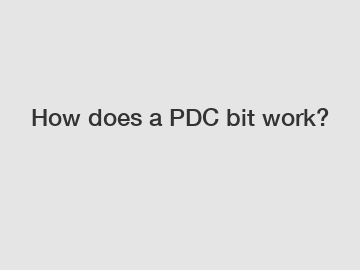How does a PDC bit work?
How Does a PDC Bit Work?
When it comes to drilling through hard rocks and formations in the oil and gas industry, one of the most essential tools is the PDC (Polycrystalline Diamond Compact) bit. This advanced drilling tool has revolutionized the drilling process, with its efficiency and durability. In this article, we will take a closer look at how a PDC bit works and its significant components.
Primary Components of a PDC Bit.

A PDC bit is comprised of several primary components that contribute to its effectiveness in drilling. These components include the bit body, PDC cutters, nozzles, and bit shanks.
- The Bit Body: The bit body is the main structure of the PDC bit, providing support and stability during the drilling operation. It is typically made of tough materials such as steel or tungsten carbide, ensuring durability and resistance to high temperatures and pressures.
- PDC Cutters: The PDC cutters are a vital part of the bit, responsible for the actual rock cutting. These cutters are made of a layer of synthetic diamond particles that are bonded to a tungsten carbide substrate. The diamond particles provide immense hardness and wear resistance, allowing the PDC bit to efficiently penetrate hard rock formations.
- Nozzles: Nozzles are strategically placed on the bit body, allowing a continuous flow of drilling fluid to cool and clean the cutting structure. These nozzles also help in removing the rock cuttings from the borehole, enhancing the drilling efficiency.
- Bit Shanks: Bit shanks connect the PDC bit to the drillstring, transmitting the rotational force and torque from the drilling rig. These shanks must be reliable and robust to withstand the immense forces during the drilling operation.
Working Mechanism of a PDC Bit.
A PDC bit utilizes its cutting structure and high rotational speed to drill into the earth's surface. As the drilling rig rotates the drillstring, the PDC cutters come into contact with the rock formations.
1. Penetration: The PDC cutters start cutting into the rock formations with their diamond-enhanced cutting edges. The synthetic diamonds have incredible hardness, allowing them to break through even the toughest rocks.
2. Crushing: Once the PDC cutters penetrate the rocks, the bit continues its rotation, exerting pressure on the rock formations. This pressure causes the rock to break and fracture, creating small pieces that can be easily removed from the borehole.
3. Fluid Circulation: The drilling fluid, also known as mud, is pumped through the drillstring and exits through the nozzles on the PDC bit. This fluid acts as a cooling and lubricating agent, preventing the bit from overheating and reducing friction between the bit and the rock.
4. Cuttings Removal: The drilling fluid carries the rock cuttings to the surface, where they are separated and disposed of. This continuous removal of cuttings ensures efficient drilling and prevents clogging of the borehole.
Conclusion.
PDC bits have transformed the drilling industry with their extraordinary efficiency and durability. The combination of tough materials, synthetic diamonds, and well-designed structures enables these bits to effortlessly drill through challenging rock formations. With the ability to maintain high drilling speeds and extended run times, PDC bits have become a go-to choice for drilling operations.
If you have any further questions or need assistance with PDC bits, please don't hesitate to contact us for more information. Our team of experts is always ready to provide you with the guidance and support you need.
If you want to learn more, please visit our website roller cone bits manufacturer, directional drill bits, multi directional drill bits price.

Comments